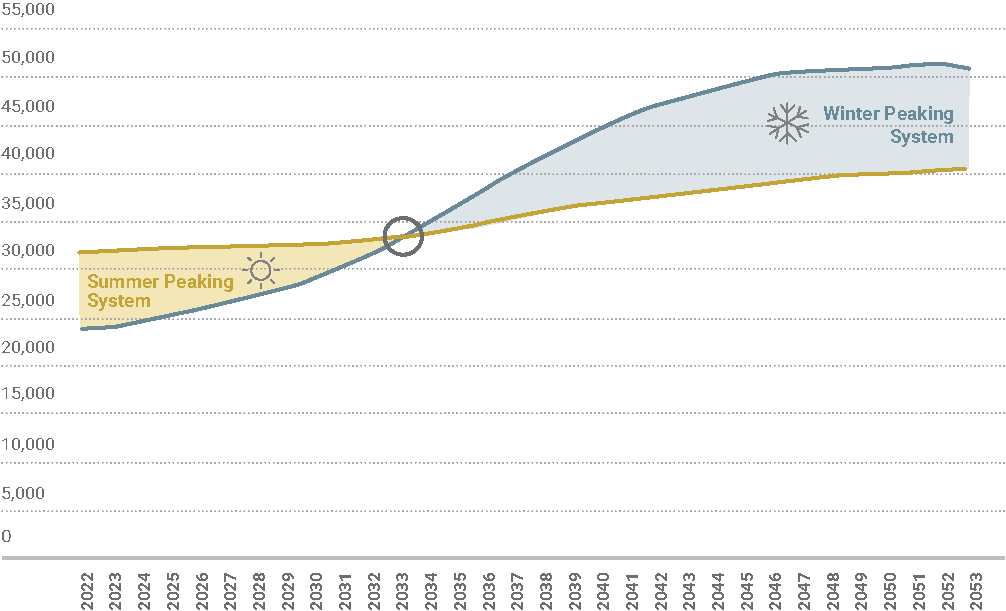January’s Polar Vortex and Lessons in Reliability for the Future Grid

The impact of January’s polar vortex on electric systems across the nation is a lesson in preparing New York’s grid for future winter reliability needs.
From January 9 through January 17, temperatures dropped 20-30 degrees below seasonal averages for tens of millions of residents across Canada and the United States. The Canadian province of Alberta experienced a low of -33 degrees on Sunday, January 14. Austin, Texas reached a low of 12 degrees on Wednesday, January 17.
The extreme cold front led several grid operators around the country to issue reliability warnings and conservation appeals, urging consumers to reduce energy consumption in efforts to avoid “load shedding,” or the deliberate shutdown of power.
AESO, the Alberta Electric System Operator, issued alerts every day from January 12 through January 15. The Southwest Power Pool (SPP) also issued a series of weather, conservation, and resource advisories. The Electric Reliability Council of Texas (ERCOT) sent several conservation appeals while setting a new peak load for the month of January. PJM, which shares a border with NYISO, issued a cold weather alert followed by a conservative operations announcement for January 14 through January 17.
At the NYISO, our mission is maintaining the reliable operation of the high-voltage electric system while also helping advance the state’s decarbonization policies. Achieving both takes a careful balance.
Essential to that balance is forecasting changes in consumer demand, the economy, evolving technology, and public policy initiatives. We must also be ready for how these things will impact grid operations in the future.
This is where the NYISO’s Planning department steps in – a team of engineers and economists who analyze what it will take to keep the lights on as the electric system transitions to renewable resources and decarbonization.
One major future change our Planning team discusses in our recently published 2023-2032 Comprehensive Reliability Plan is the shift of the grid from a summer-peaking system, when consumer demand for air conditioning spikes, to a winter-peaking system driven primarily by space heating and electric vehicle charging. This shift is expected to happen by 2033 but it could come earlier.

Zach Smith, the NYISO’s Vice President of System and Resource Planning, says transitioning from a summer-peaking system to a winter-peaking system is a significant challenge that we must start to address now. “We see deficiencies in serving increased demand as early as winter 2027-2028 during an extreme 1-in-100-year winter cold snap, coupled with a shortage of gas fuel supply,” Smith says. “Addressing those challenges is complicated by the fact that planning for fuel availability, cold snaps, and other extreme weather events is not established reliability criteria. That’s something we should look at.”
Robb Pike is the NYISO’s Vice President of Market Operations. Part of his role is using the forecasting data Zach Smith’s team puts together to prepare the competitive electric markets for the transition to more renewable resources.
“Wind and solar are intermittent technologies, so as we rely more on these technologies to heat our homes and power our cars, we will need other resources to fill gaps in generation when the wind doesn’t blow, and the sun is behind the clouds,” Pike says. “The anticipation of a multi-day heatwave that maximizes air conditioner usage across the state has been the key challenge we planned and operated the system to historically. That’s about to change in dramatic fashion.”
Moving forward, winter season reliability needs will redefine the critical operating challenges, Pike says. According to the United States Energy Information Administration, just 15.3% of residential households in New York rely on electricity for heating. And while energy efficiency will continue to be crucial, forecasting data included in the CRP expects that these programs will be unable to materially offset the expected growth in winter season demand.
According to findings in the CRP, by the end of the decade, winter peak demand is projected to be climbing at a rate of 1,000 MW per year, and by 2033 to be growing by almost 1,500 MW per year. Under scenarios assuming more aggressive electrification, winter peaking conditions could occur as early as 2030, at which point winter demand would be growing by 2,000 MW per year.
Alternatively, delays in the adoption of heat pumps and electric vehicles could slow the growth in winter loads. And while the transition timing remains uncertain, the current annual growth rate in winter demand highlights the importance of proactively identifying reliability needs and adjusting current practices to address the increased reliability risk.
We need to continue to grow the winter resource fleet, but as Emilie Nelson, the NYISO’s Chief Operating Officer, points out, we’re not siting new generation fast enough as we stare down the coming winter reliability needs.
“The resource gap is a growing concern. We want to transition to a renewable, decarbonized electric grid as fast as possible,” Nelson says. “But, during the transition, we must also make sure we have reliable resources to fall back on in extreme weather situations to protect the health and safety of New Yorkers.”
Nelson says this means we must carefully evaluate any retirements of the existing fleet of resources that are currently providing critical reliability functions. Generating units in the downstate area, for instance, have the ability to burn either natural gas or oil, something that proved crucial in 2022 during winter storm Elliott as well as during the recent cold spell in January.
